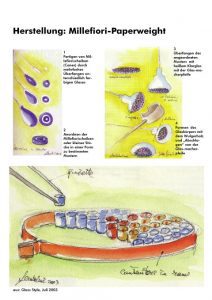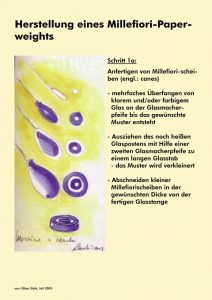History of the Paperweights - German/German

The coloured glass balls first appeared in the middle of the 19th century. At that time, the letter was the most important form of communication and countless letters piled up in the comptoir or on the private secretary. To protect these stacks from unexpected gusts of wind, the letters were secured with a heavy object: the paperweight.
Paperweights have been around since the Chinese invented paper in 105 BC. At that time, they were not made of glass, but of valuable woods, for example. The hemispherical paperweights filled with coloured glass did not appear until 1840.

The technical know-how for the manufacturing process was already possessed by the Egyptians and Romans: the production of coloured glass, the fusing of different coloured glasses together and the drawing of patterned glass rods, the thread glass, spiral glass or millefiori rods.
All this knowledge was then lost and was only "reinvented" again much later: first in Venice around 1500 and 1836, and at the end of the 18th century in the cottages north of the Alps. The newly developed techniques were first used by the smelters for their common products such as plates, flacons, cutlery handles or knobs. Thrifty glassmakers then came up with an idea: they poured clear glass over the pieces left over from the day's production at the end of a working day on millefiori, thread and spiral glass rods and formed them into a ball. This way they always had small and cheap gifts ready to take home.
A businessman from Italy, Pietro Bigaglia, made the leftover glass balls produced by the glassmakers marketable as paperweights. In 1845, he unceremoniously took a few specimens to the industrial exhibition in Vienna and offered them there as "press paper" and "paper pushers". He caused such a sensation that leading crystal glass manufacturers in France, Silesia and Bohemia began producing glass paperweights almost simultaneously. A little later, England and, from 1850, the first glassworks in North America also entered the business.
Until around 1860/70, partly until 1900, the paperweights that are now called "classics" were created. And they were made using very labour-intensive methods and still entirely in the style of Biedermeier and early Historicism. Dealers sold them to shops and souvenir shops in New York, Paris and London, where they were in great demand as unusual wedding and birthday gifts. And everyone of distinction began to collect them even then. Among them were such famous personalities as Empress Eugenie of France and Queen Victoria, and a little later Queen Mary of England.
The History of Paperweights - English

These coloured glass balls first appeared in the mid 19th century at a time when the letter was the most important form of communication and numbers of them would be stacked on the comptoir or private secretaire. A heavy object in the form of a paperweight was used to prevent them from being scattered by sudden blasts of air.
But paperweights had existed since the Chinese discovered paper in 105 BC; naturally these weren't made of glass, but of precious woods for example. The semi-circular paperweights filled with coloured glass first appeared in 1840.
The Egyptians and the Romans had the technical know-how to produce coloured glass, melt different coloured glasses together and draw patterned glass rods into glass fibre, spiral glass, or millefiori canes.
 But all this knowledge was lost and was only "re-invented," much later in Venice in around 1500 and 1836 and at the end of the 18th century in glass foundries north of the alps. At first, the foundries used the newly developed techniques for their established products such as plates, flacons, cutlery handles or buttons. But frugal glass makers came up with a new idea: they poured clear molten glass over the scrap pieces of millefiori, fibres, or spiral rods remaining from the day's production and shaped them into a ball. This meant they always had small and cheap presents at their fingertips that they could take home with them.
But all this knowledge was lost and was only "re-invented," much later in Venice in around 1500 and 1836 and at the end of the 18th century in glass foundries north of the alps. At first, the foundries used the newly developed techniques for their established products such as plates, flacons, cutlery handles or buttons. But frugal glass makers came up with a new idea: they poured clear molten glass over the scrap pieces of millefiori, fibres, or spiral rods remaining from the day's production and shaped them into a ball. This meant they always had small and cheap presents at their fingertips that they could take home with them.
An Italian businessman called Pietro Bigaglia, made these "scrap glass balls," marketable as paperweights. Without a second thought, he took a couple of examples with him to the Industrial Exhibition in Vienna in 1845 and put them on sale as "paper presses". He caused such a sensation that leading crystal glass factories in France, Silesia and Bohemia began to produce glass paperweights more or less simultaneously. England joined the trend a little later and the first North American glass foundries also jumped on the business bandwagon from 1850 onwards.
What are described as "classic," paperweights today, were produced from between 1860/70 until around 1900 in part using very labour-intensive methods in the typical style of Biedermeier and early historicism. Traders sold them to businesses and souvenir shops in New York, Paris and London, where they were especially coveted as unusual birthday, or wedding presents. Everyone with a name and social status began to collect them; including very famous personalities such as Empress Eugenie of France, Queen Victoria, and some time later Queen Mary of England.